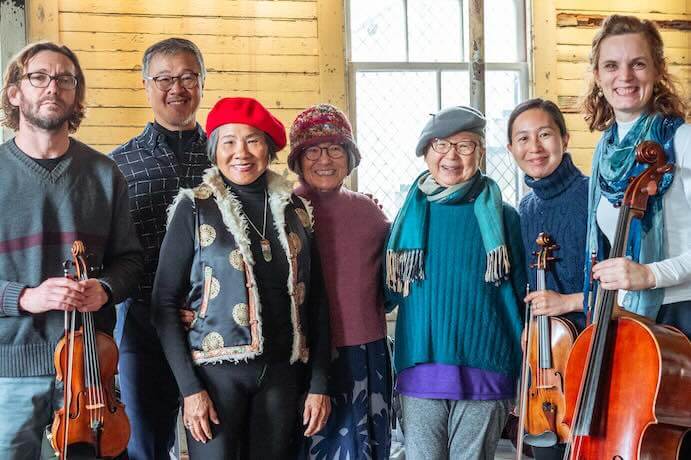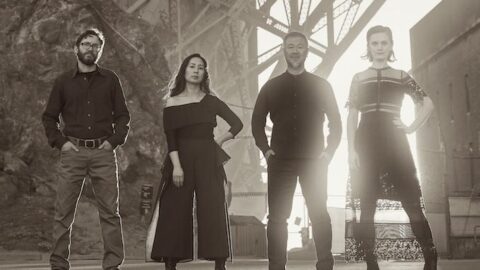For three decades, Del Sol Quartet has been committed to the music of our time. But with their Angel Island project, the group is looking back on local history and tracing its resonance to the present day.
Located in the San Francisco Bay, Angel Island is sometimes known as the “Ellis Island of the West,” but its story contains a darker history. During a 30-year period from 1910 to 1940, Asian immigrants to the United States, mostly of Chinese origin, were detained, questioned, and subject to racist and humiliating treatment at the Angel Island Immigration Station.
Approximately 500,000 immigrants arrived and were processed at Angel Island, with about 300,000 being detained. Chinese immigrants represented over one third of detainees and could be held for days at a time or even years. Their harsh treatment was due to the lasting effects of the discriminatory Chinese Exclusion Act of 1882: the first law restricting U.S. immigration. It set forth a 10-year ban on Chinese laborers immigrating to the U.S. and also declared existing Chinese immigrants ineligible for citizenship.
When the Angel Island station was to be demolished in 1970, over 200 poems and other inscriptions were discovered carved into the barracks’ walls. These mostly anonymous poems form the basis of the ANGEL ISLAND: Oratorio, commissioned by Del Sol Quartet and composed by Chinese-born composer Huang Ruo. The work premiered in 2021 on the island, which is now a state park, before touring nationally and internationally.
Del Sol’s Angel Island project has expanded to include a new concert series, “Music and Migration,” held inside Angel Island’s detention barracks. Each concert is curated by a different member of the quartet and explores the stories of the multiple communities that share a history on the island. In advance of their performance on June 15, we asked Del Sol cellist Kathryn Bates about the evolution of the project.

What are some of the logistical elements of producing a concert and performing at Angel Island, seeing as how travel to and from the island isn’t just a quick car ride?
My daughter, at age 4, told some friends that our family owned a boat. We don’t, she just thinks the Angel Island State Park staff boat is her personal family boat. I think this captures the spirit of producing and performing on Angel Island – it starts with a lot of boat rides and working with friendly state-park employees.
There are performer logistics: “don’t be late because you WILL miss the staff boat” (yes this happens). There are audience logistics – clearly communicating how to get to the immigration station from ferries to the 1 mile walk/bike/shuttle.
The ferry logistics are always a challenge: the lack of a cohesive Bay Area ferry system, the cancellation of the SF-Angel Island route during the pandemic, the route revival for “commuters” with limited weekend service, in conflict to actual usage. Ferries change their schedule last minute, forcing us to change our performance times. We have to cut music that’s too long so we don’t miss the last boat. There’s also the dance between the Angel Island State Park and the Immigration Station Foundation. It’s always an adventure.
Engaging our various senses can help us more readily absorb information. Do you think that experiencing music and dance performances based on the history of Angel Island helps people more genuinely contemplate our country’s discrimination against immigrants, especially those of Asian descent?
We can never guarantee what people think about. What we can do as artists is to give people an opportunity, a set-apart time, to contemplate ideas. Our work around Angel Island presents a lot of history and information that audience members might not otherwise come across. We’ve looked deeply at the detention of Chinese immigrants due to the Chinese Exclusion act. Over the next year, we’re exploring different groups that came through the island: the Japanese picture brides, Jews escaping the Bolshevik revolution and later the Nazis, and Koreans escaping Japanese occupation.
Using the beauty and complexity of contemporary music, the experience can viscerally lift the history off the pages of a textbook. It also helps us connect to current conversations. Things such as: how have policies and ideas remained unchanged with what’s happening at our southern border? How is Florida’s recent ban on Chinese nationals from buying property (including US residents) reminiscent of the Exclusion Act?
The work we’ve done has been more about opening the conversation, creating space for dialogue. We have found that it’s a good way of engaging people, that they really do connect more directly with the story because of the music. It’s interesting to note: the reason the immigration barracks were saved was not because it was a historic building, but because of the Chinese poetry found carved into the walls. It seems fitting to continue to use the arts to tell this story.
This ongoing concert series began almost by chance. Huang Ruo’s ANGEL ISLAND: Oratorio was supposed to be premiered outside the immigration station, not inside, since it was 2021. Due to an impending atmospheric-river-bomb-cyclone rain, we spontaneously had to move indoors. The music vibrated so richly from the walls where the Chinese characters formed poetry, capturing the hopes and dreams and disappointments of detained immigrants. The space was such a powerful, immersive experience, we knew we needed to continue.
Despite being extremely visible from around the Bay, Angel Island isn’t in the mainstream consciousness. Yet, it’s an incredible treasure, both geographically and historically. So, we want to encourage people to go. We’re giving them a reason. Can we help promote Angel Island tourism, raising its annual 20,000 visitors to a number closer to Ellis Island’s 3 million? We believe that infrastructure, support, and historical/cultural recognition will grow as more people have experienced the island.

Could you describe some audience feedback you’ve received from people who claim a personal connection to the island’s history? What was that experience like for you as musicians, to know that your performance helped facilitate such a meaningful moment?
There’s been a lot of tears on all sides, whether Angel Island descendants or people who encounter this history for the first time. One audience member shared: “It was a beautiful tribute to the sufferings of that experience. My grandfather was kept at Angel Island two times, when he was 12 and 18 years old. He contributed to the poems on the walls. My mom cried.”
It’s important to understand that this history was full of shame and secrecy for the Chinese American community. Author/poet Genny Lim recalls how difficult it was to find people willing to talk about their experience, when she worked with Him Mark Lai and Judy Young to publish “Island,” the first book on the Angel Island poetry and history. So, to bring this history to international attention, to give a community working tirelessly for 40+ years extra recognition, yes, it’s been so satisfying that we’ve done something so meaningful.
In this case, we’re proud to say we shifted the narrative a bit. Something that people had felt reluctant to talk about, felt ashamed of – now there’s a new point of pride in this connection, a greater understanding from the outside of their own history. Victor Yan, an early Chinatown community activist, eloquently recited the Angel Island poetry in Cantonese at several events and exclaimed “it felt like Chinese New Year!”
That’s the spirit we bring to the series. So we inaugurated our series with something that brings us joy – our continued collaboration with community arts advocate Andi Wong and The Last Hoisan Poets (Flo Oy Wong, Nellie Wong, and Genny Lim), three powerful Chinese female poets who work to preserve their native dialect, spoken by most early Angel Island Chinese detainees.
Why is the idea of fostering community so central to the mission of your ensemble?
In our new podcast “Sounds Current: Angel Island,” you can follow our deep dive on this topic. Ben tells a great story about a community barn bringing people together through the arts.
We are a quartet that deeply cares about connecting with people through our music. Our founding violist Charlton Lee actually left experimental physics research because he wanted to do something which reaches more people. The joke is that he started a new music string quartet. Each of us – Hyeyung, Ben, Charlton and myself – values feeling like we have something to contribute. Every Del Sol idea stems from a desire to be relevant, in some specific way, to the community around us.
In San Francisco, for us, it feels different. We aren’t tied to any institution, so we need to keep our fingers on the pulse of what’s happening. Our connection to the audience feels quite direct. So we invite people in, to be part of the process, to dialogue: as individuals, artists, collaborators, thinkers, organizations….as communities. It becomes all of our art, not just mine or yours. I think that is, in part, what made the Angel Island work so powerful.

You have worked with many local cultural organizations throughout your projects. Angel Island has a long Indigenous history as well, having been used as a hunting and fishing site by Coast Miwok Native Americans. Do your future plans include any collaborations with local groups to bring those stories to audiences?
What I find so captivating about the island is the richness and complexity of its history. I personally learn something new every time I’m on the island. Juxtaposing great beauty with a dark past, it creates a snapshot of American and Bay Area history. It’s why we wanted to continue to dig in, beyond Huang Ruo’s incredible work.
Up until this point, our work has been entirely centered around the poetry left behind by Chinese detainees, in direct collaboration with cultural and historical organizations that have fought, against odds, to preserve this history. With the Angel Island Immigration Station Foundation, we are now in the early stages of producing this new series, which uses new music to specifically highlight their archives of historic immigrants.
But the work doesn’t stop there. I want to point to “A Year on Angel Island” – a year-long series of performances, conversations, exhibitions, and courses at University of California – Berkeley, produced by Susan Moffat at UCB’s Future Histories Lab. In its multitude of activities, which included Huang Ruo’s oratorio, it could only begin to scratch at the surface of what Angel Island is. This included an important conversation with author Greg Sarris, Tribal Chairman of the Federated Indians of Graton Rancheria (Coast Miwok).
Our eventual goal is to explore that multitude with the on-island series, expanding to the island’s known history outside of the immigration station, which begins over 1000 years ago with the Coast Miwok arriving on tule reed boats.
I CARE IF YOU LISTEN is an editorially-independent program of the American Composers Forum, and is made possible thanks to generous donor and institutional support. Opinions expressed are solely those of the author and may not represent the views of ICIYL or ACF.
You can support the work of ICIYL with a tax-deductible gift to ACF. For more on ACF, visit the “At ACF” section or composersforum.org.
























